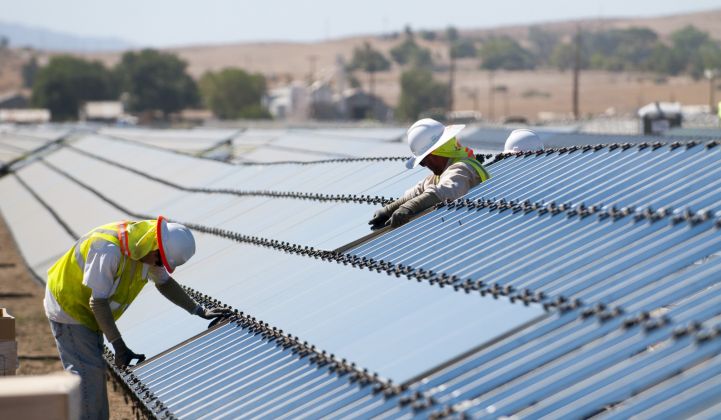First Solar swung to a first-quarter loss due to lower project revenue and escalating costs at its engineering, procurement and construction business, but reassured investors that the rollout of its critical Series 6 modules is proceeding as planned.
The U.S. solar group announced a net loss of $67.6 million for the first quarter of 2019, compared to an $83 million profit in the comparable quarter last year.
Net sales fell 6 percent year-over-year to $532 million, though the company raised its full-year sales guidance to $3.5 billion to $3.7 billion, up from a prior range of $3.25 billion to $3.45 billion.
First Solar attributed its loss to lower project revenue in the U.S. and Japan and difficulty keeping costs down within its engineering, procurement and construction business. Citing a tight labor market, materials issues and weather delays, the company said it would be restructuring that arm and bringing in new leadership to help cut costs.
First Solar chased the negative results with positive news about progress ramping capacity for its Series 6 thin-film modules at its global factories and what CEO Mark Widmar called a “robust” 1.1 gigawatts of bookings since its last earnings call. The company has booked 2.3 gigawatts since the beginning of the year and is largely sold out through 2020, with half of its anticipated supply already booked into Q1 2021.
Looking ahead, the company said increased demand from corporate and industrial customers as well as a surge in state clean energy policies will help drive continued growth in its core U.S. market.
“There’s a tremendous amount of momentum and there are numerous catalysts that are driving the global opportunity for PV,” Widmar said on a Thursday earnings call. “All indicators point to growth.”
Widmar noted “significant operational improvements” at First Solar’s Series 6 module factories and the ramping of the second Vietnam factory. The company projects cost per watt for Series 6 modules will drop 30 percent from Q1 to Q4. From February to April, megawatts produced per day for Series 6 have increased 34 percent.
Construction continues at the company’s second Ohio plant, announced in April of 2018, with production slated to start in early 2020. Widmar said the first tools are scheduled for installation by the end of Q2 and progress is on track.
Once the Ohio factory is complete, First Solar will have 5.4 gigawatts of Series 6 capacity in five factories around the world. The great majority of its 1.1 gigawatts of bookings, 900 megawatts, came from the U.S., though that encompasses orders for both its Series 4 and Series 6 products.
“Series 6 demand remains robust, and we are encouraged by the strong year-to-date bookings, which are on track to exceed our targeted [one-to-one] annual bookings-to-shipments ratio,” said Widmar.
As First Solar continues to ramp Series 6 production, Widmar said it should offer a competitive edge as other manufacturers like Longi expand monocrystalline capacity. Earlier this week, Longi and JinkoSolar announced capacity increases for that next generation technology.
“Our objective is we need to create a technology advantage and separation that has the lowest-cost production in the marketplace,” said Widmar. “The challenges in front of us are probably even greater than they have been in the past, but that’s why we made the decision to move toward Series 6.”




